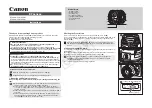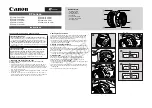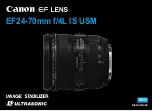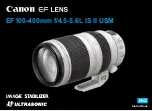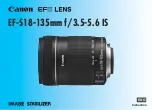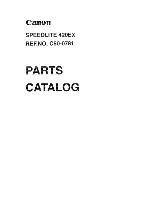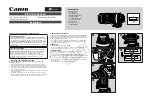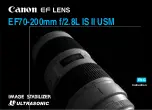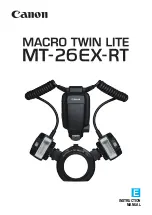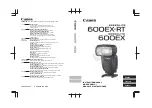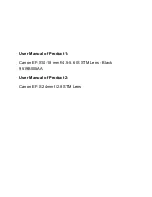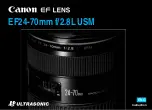
28
Recording Options
The EOS-1Ds Mark III offers some highly flexi-
ble image recording options. With the
Wireless File Transmitter WFT-E2 II A*, users
can download directly to a compatible
portable USB hard drive. Compatible devices
range from popular and convenient USB thumb
drives to many portable USB hard drives. With
the CF card, SD card and external media, the
following recording functions can be used:
• Standard: Images are recorded onto one
card (or connected hard drive).
• Automatic switching of recording media: When
the current recording medium becomes full,
the camera switches to another automatically
and continues recording without interruption.
• Separate recording: A captured image can be
recorded in different image sizes on different
media. Each recording medium can be set to
record a specific image size (L, M1, M2, S,
RAW, sRAW) for each shot.
• Recording of identical images: A back-up
mode, this records the exact same file type
and size onto two cards and/or a connected
hard drive.
SDHC (SD High-Capacity) is a memory
card standard (SDA Ver.2.00) to handle high-
capacity data from 2GB to 32GB. Because it is
compatible with SDHC, the camera can be used
with SD cards having a capacity up to 32GB.
Security
If the slot cover of the EOS-1Ds Mark III is
opened during the writing operation, an alarm
sounds and a warning message appears on
the screen to indicate that writing is in
progress. The card writing continues even if
the slot cover is opened. Also, if you set the
power switch to <OFF> during the card writing,
a message appears on the screen to indicate
that writing is in progress. After the writing is
completed, the power turns off.
You can protect individual images, all
images in a folder, or all images on the card.
Alternately, you can cancel image protection.
You can erase individual images, all images
in a folder, all images in the card, or just
check-marked images. Unprotected images
will be erased.
Copying Image Files
Selected images, a folder of images, or the
entire contents of any memory card can be
copied by the photographer onto another
memory card — or attached USB hard drive —
at any time. This gives the ability to make
back-up copies of
important images,
whenever it’s
appropriate. If the
Canon Wireless
File Transmitter
WFT-E2 II A* or
WFT-E2A is used, a compatible USB-enabled
hard drive can be attached directly to the trans-
mitter’s USB port. Instead of having to bring a
laptop computer on location, a photographer
can quickly copy their files to a high-capacity
hard drive during a break in shooting. It’s an
ideal option to provide security and peace of
mind to the working professional.
*This device has not been authorized as required by the rules
of the Federal Communications Commission. This device is not,
and may not, be offered for sale or lease, or sold or leased,
until authorization is obtained.
Recording Quality Specifications: EOS-1Ds Mark III
Image Size
Pixels
[Approx.
MB]
File Size
[Approx.
MB]
Possible
Shots
[Approx.]
Maximum Burst
[Approx.]
Hi-
Speed
Low-
Speed
Printing
Size
L (Large)
M1 (Medium1)
M2 (Medium2)
S (Small)
RAW
RAW+
sRAW
RAW+
L (Large)
M1 (Medium1)
M2 (Medium2)
S (Small)
L (Large)
M1 (Medium1)
M2 (Medium2)
S (Small)
21.0
(5,616x3,744)
16.0
(4,992x3,328)
11
(4,080x2,720)
5.2
(2,784x1,856)
21.0
(5,616x3,744)
5.2
(2,784x1,856)
6.4
5.2
3.9
2.2
25.0
25.0+6.4
25.0+5.2
25.0+3.9
25.0+2.2
14.5
14.5+6.4
14.5+5.2
14.5+3.9
14.5+2.2
290
350
470
840
75
54
57
60
64
130
82
90
97
100
56
73
110
160
12
10
10
12
12
18
12
12
12
18
83
140
300
890
14
10
10
12
12
24
14
14
18
20
A2
or Larger
Around
A2
Around
A3
Around
A4
A2
or Larger
—
Around
A4
—
The size of one image, number of possible shots (also related to
battery life) and continuous shooting speed are based on JPEG
quality 8, ISO 100, Standard Picture Style, Canon’s testing stan-
dards and a 1GB CF card. (These figures vary depending on the
subject, memory card brands, ISO speed, Picture Style, etc.)
Professional Features
Revised and Simplified Operation
Canon has thoroughly investigated ways to make
camera operation easier. The camera uses the
EOS Digital line’s basic operation method with
the Main Dial, Quick Control Dial, Multi-con-
troller, SET button and other buttons to select
and set various functions. Also, the ISO speed
button, AF Start (AF-ON) button, Picture Style
button, and Memory selection/Image size/White
balance function button have been added to
make camera operation easier.
With the older EOS-1D series cameras, the
basic shooting operation logic consisted of
holding down a button and turning the Main
Dial or Quick Control Dial to select a setting.
However, with the Mark III series, when you
press a button, it remains active for a while so
you can let it go and then turn a dial to set
something. Several buttons are multi-
purpose — press once and turn either the top
Main Dial or rear Quick Control Dial for the
respective functions.
The Multi-controller on the rear is used to
select Menu headings, and provides several
AF functions as well. If the AF point select
button is pressed once, a push on the Multi-
controller toggles between selecting the center
AF point and Automatic AF point select mode.
The cameras can also memorize any of the 19
user-selectable AF points, and instantly jump
back to it when you press the Multi-controller.
27
“snap,” making it easy for photographers to
tell when an image pops into sharp focus. All
previous Ec-series focus screens can be used
in EOS-1Ds Mark III. Since the eyepiece frame
now has a different
shape to accommodate
the bigger eyepiece lens,
Eg-series viewfinder
accessories have been
developed: Eyecup Eg,
Dioptric Adjustment Lenses Eg (7 types: -4, -3,
-2, 0, +1, +2, +3), and Anti-fog Eyepiece Eg.
The standard Eyecup Eg has a mount for
attaching it to the eyepiece. It is less likely to
detach inadvertently.
Wide-view 3.0-inch LCD Monitor
The large, 3.0-inch wide TFT monitor features
approximately 230,000 pixels, a wide viewing
angle (140° both vertically and horizontally),
high-level brightness and low power con-
sumption. The LCD monitor is backlit with
four LED modules. The maximum brightness
setting makes it easier to see the image on
the LCD monitor even in bright outdoor condi-
tions. The seven brightness adjustment levels
make the camera more adaptable to environ-
mental condi-
tions. A large,
clear gray scale
is provided for
guidance. Also,
the color repro-
duction range
has been increased to more closely simulate a
personal computer monitor. The LCD monitor
is not only larger, but easier to use and the
display is more informative than ever.
Weather-resistant System
The legendarily excellent water- and dust-
resistant construction measures are incorpo-
rated at 76 places around the camera controls
and along cover seams. Also, O-rings are used
on the memory card slot covers and the battery
compartment, and silicon rubber is employed
around the top and rear covers and buttons
where the user can
see it and feel reas-
sured. The camera’s
hot shoe is shaped to
resist water with a rib around its perimeter.
When the Speedlite 580EX II is attached, water
resistance is maintained. When a water-resistant
EF lens is attached to the camera, the entire
camera-and-lens outfit will be moisture- and
dust-resistant.
Clear, Sharper Viewfinder
The EOS-1Ds Mark III’s viewfinder has approx-
imately 100% coverage, 0.75x magnification, a
35° angle of view, a 20mm eyepoint, -3 to +1
dpt. dioptric adjustment and an eyepiece
shutter that is gray to make it easier to see
when it is closed.
The viewfinder’s optics have been devel-
oped to achieve best-in-class performance. A
highly refractive material is used for the pen-
taprism of the EOS-1Ds Mark III. To improve
viewfinder magnification, a larger pentaprism
is employed. The basic configuration of the
eyepiece optics has four lens elements.
However, by increasing lens power, high
magnification is attained. Finally, the finder’s
parts are fabricated with greater precision
for more consistent performance at higher
magnifications.
The Ec-C IV focusing screen is a Laser Matte
unit whose molding method has been improved
over the previous Ec-C III focusing screen’s.
It makes it easier to focus and provides natural-
looking background blur (bokeh). It is also
brighter and less grainy, making it a very
well-balanced focusing screen. The dispersion
characteristic is improved, and the screen is
bright with minimal flare. The Ec-C IV focus
screen gives superb contrast and visual
Pentaprism
Backlight lens
SI-LED
Metering lens
Condenser lens
SI prism 1
SI prism 2
H-LED
H-LCD prism
Eyepiece lens
V-LCD
V-LCD prism
Metering sensor
SI lens 2
SI mirror
SI lens 1
SI-LCD
Focusing screen
Ec-C IV
Ec-C III
Fresnel
lens area
Cross section of
fresnel lens
Major Viewfinder Specifications
Item
EOS-1Ds Mark III
EOS-1D Mark III
Coverage [Approx.]
100%
Magnification
0.75x
0.76x
Viewing Angle
35°
30°
Eye point [Approx.]
20mm
Dioptric adjustment
-3 to +1 dpt
Viewfinder Optics
Magnified Screen
Location of Major Water-resistant Measures
•Metering Mode
•JPEG/RAW Recording
•Battery Charge Level
•ISO
TECHNOLOGY
Eyecup Eg
LCD Viewing Angle
Vertical
Viewing
Angle
Horizontal Viewing Angle
LCD Brightness
Info button
AF start button
AF start button
Multi-controller
Setting button
ISO speed button
Quick Control Dial switch
Function button
(WB/Recording media/
Image size selection button)
AF/Drive mode
selection button
Picture Style selection button
Camera Control Modifications
On-screen message
if the slot cover is opened
On-screen message
if the power switch is set to <OFF>
Creating and selecting a folder






























